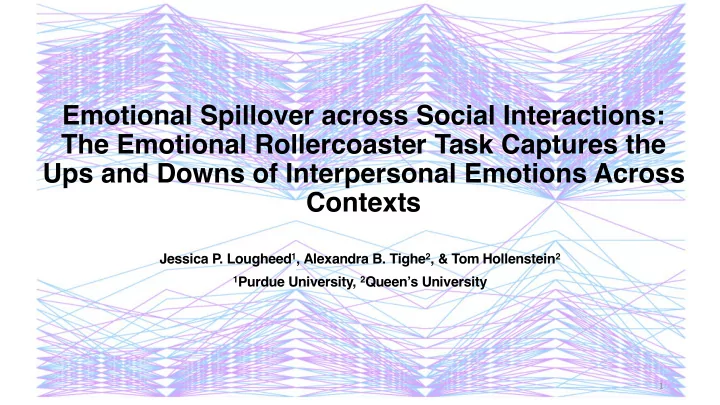

Emotional Spillover across Social Interactions: The Emotional Rollercoaster Task Captures the Ups and Downs of Interpersonal Emotions Across Contexts Jessica P. Lougheed 1 , Alexandra B. Tighe 2 , & Tom Hollenstein 2 1 Purdue University, 2 Queen’s University 1
Emotional Spillover • Negative emotions are a part of life and have important functions in close relationships • How to close relationship partners adjust to changing interpersonal situations? 2
Emotional Spillover & Repair • Previous research on parent-child dyads showed that families who improved during treatment for children’s externalizing problems showed the ability to emotionally repair after a conflict discussion A: Positive discussion (e.g., B: Conflict discussion (e.g., A: Positive discussion (e.g., planning a hypothetical curfew) planning a hypothetical party) vacation) • Design involves setting up a situation where carryover effects can occur (i.e., spillover) • Challenges of this A-B-A design relate to conflicts being heterogeneous: • Can elicit different types of emotions (anger, worry, neutral) at different intensities • Not always evocative; might depend on age 3 Granic et al., 2007; Hollenstein & Lewis, 2006
The Current Study • Two guiding questions: • Can we examine dyadic repair from specific types of emotional experiences (e.g., sadness, worry)? • Are some negative emotional contexts harder to repair than others? • Task design goals: • Maximize carryover effects across contexts • Be appropriate for a broad range of ages • Allow examining multiple opportunities for repair 4
Design Participants • 96 mother-daughter dyads • Typically-developing community sample • Adolescents aged 13-16 years old Procedure • Lab visit • Emotional Rollercoaster task: Five 3-minute discussions, ABABA design Happy/ Proud Frustrated/ Worried/ Grateful Excited Annoyed Sad 5 Lougheed & Hollenstein, 2016
Measures Daughters Mothers Mean self-reported positive emotions • Modified Positive and Negative Self-reported positive emotions Affect Schedule • 10 emotion items, rated from 1 (not at all) to 5 (extremely) • Measured at baseline and immediately after each discussion • Self-reported emotions were observed in the expected directions for both mothers and Mean self-reported negative daughters emotions Baseline Happy/ Excited Worried/ Sad Proud Frustrated/ Grateful 6 Annoyed Discussion
Measures Psychosocial Adjustment • Depression, General Anxiety, Social Anxiety Expressed Emotions • Coding with five-code SPAFF Code Expressions Externalizing Negative Emotions Anger, Contempt Internalizing Negative Emotions Sadness, Worry Neutral Expressions neither negative nor positive Interest/ Curiosity Active interest, validation Positive Emotions Humor, Joy, Affection 7
Data Preparation: Dyadic time series to state space grid ID Time Discussion Daughter Mother 3 0 Happy/ Excited Neutral Neutral 3 1 Happy/ Excited Neutral Neutral 3 2 Happy/ Excited Neutral Neutral 3 3 Happy/ Excited Neutral Neutral 3 4 Happy/ Excited Neutral Neutral 3 5 Happy/ Excited Neutral Neutral Positive Interest Daughter Neutral Internalizing Externalizing Externalizing Internalizing Neutral Interest Positive 8 Mother
Discussion 1: Happy/Excited 9
Socioemotional Flexibility Discussion 4: Frustrated/Annoyed The ability to adjust emotions according to situational demands • Dispersion: • Range of dyadic states across the grid • Transitions: • Number of changes between cells on the grid Expected to find that adjustment (internalizing Discussion 5: Grateful symptoms, relationship quality) is related to how parents and teens will manage the ups and downs of changing situations 10 Hollenstein et al., 2013
Research Question and Hypothesis Are dyad-level individual differences in flexibility associated with psychosocial adjustment (depressive, general anxiety, social anxiety symptoms)? 11 Grimm, Ram, & Estabrook, 2017; Nagin, 2005
Results 0.8 80 0.7 70 0.6 60 Transitions (Mean) Dispersion (Mean) 0.5 50 0.4 40 Low Flexibility Low Flexibility Average Flexibility Average Flexibility 0.3 30 High Flexibility High Flexibility Sample mean Sample mean 0.2 20 0.1 10 0 0 Discussion 1: Discussion 2: Discussion 3: Discussion 4: Discussion 5: Discussion 1: Discussion 2: Discussion 3: Discussion 4: Discussion 5: Happy/ Excited Worried/ Sad Proud Frustrated/ Grateful Happy/ Excited Worried/ Sad Proud Frustrated/ Grateful Annoyed Annoyed Task Task Plots of the changes in flexibility across the five discussion tasks in terms of (a) Dispersion and (b) Transitions. Note. Error bars represent the standard error of the mean. Low Flexibility: n = 24 Average Flexibility: n = 57 High Flexibility: n = 14 Lougheed & Hollenstein, 2016, Emotion 12
Discussion Discussion 4: Frustrated/Annoyed • Emotional Rollercoaster task elicited emotions in the expected directions • Flexibility/Spillover/Repair: all groups showed similar patterns of change across discussions, just different levels • Moderate level of dyadic flexibility Discussion 5: Grateful was associated with better psychosocial adjustment (maternal internalizing symptoms, relationship quality) 13
Limitations and Future Directions • Analysis: • Look at what emotions are expressed in addition to flexibility patterns • E.g., How long does it take to return to mutual positivity after a negative interaction? • Examine mediation across contexts • E.g., Do dynamics in Discussion 2 mediate the association between dynamics in Discussion 1 and Discussion 3? • Task: • Counterbalance order of discussion topics? • More diverse sample 14
Discussion 4: Frustrated/Annoyed Thank you! jlougheed@purdue.edu @jp_lougheed Discussion 5: Grateful Grant 386479-2011 from the Natural Sciences and Engineering Research Council of Canada held by Tom Hollenstein 15
Recommend
More recommend